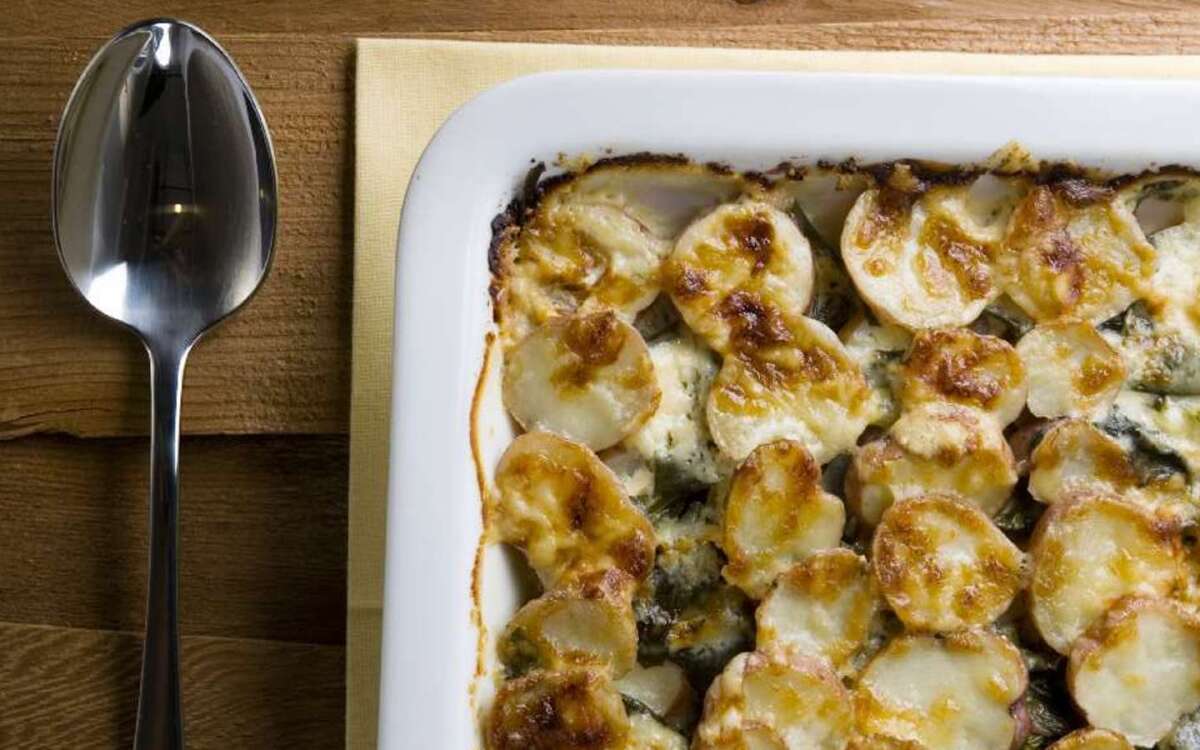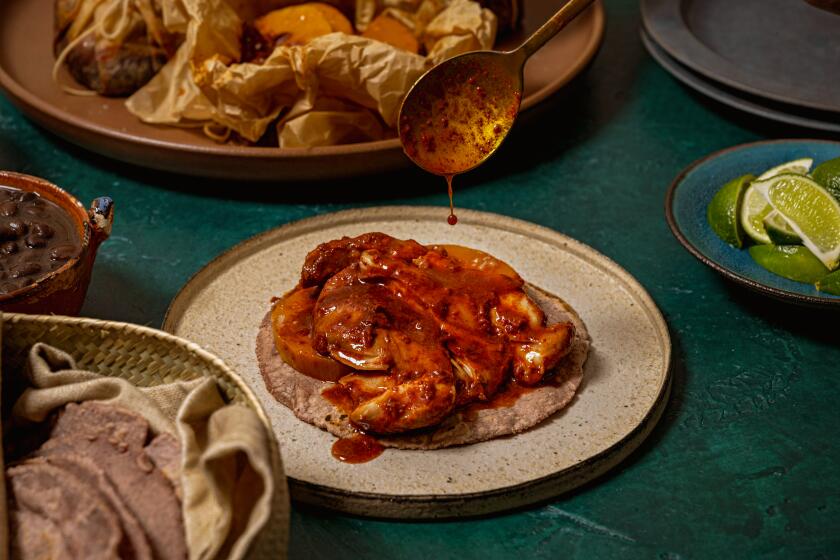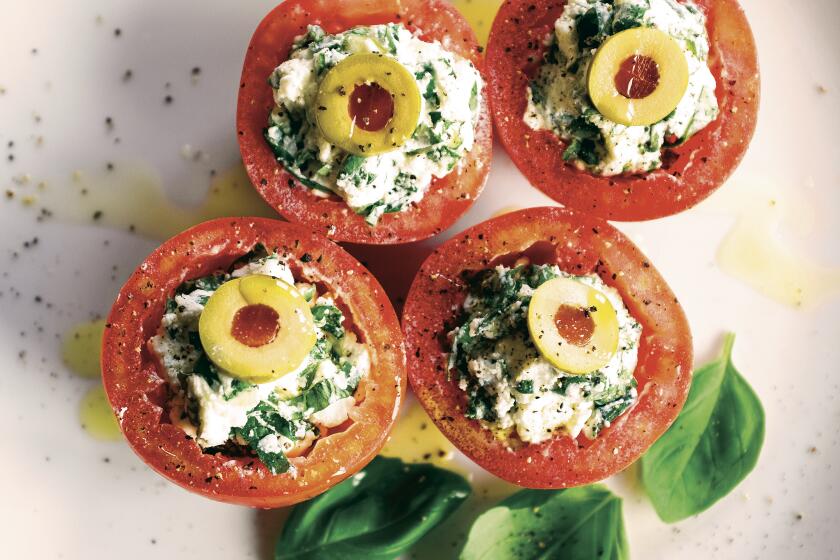Dandelion green and new potato gratin

- Share via
Gratins have a bit of seasonal affective disorder. They turn up in fall and winter but disappear when the sun comes back out in springtime. Which is surprising considering how well everything at peak of green right now goes with cheese and sauce, and how easily a quick pass through the oven makes them all rich and bubbly together. Asparagus, artichokes, green garlic, dandelions, even not-so-green new potatoes can be transformed by the gratin treatment.
The super-fresh aspect makes gratins especially tantalizing once you start to feel a little bored by the vegetables that tasted so new just weeks ago. A steamed artichoke is always a thing of satisfying beauty, but if you pare it to its heart, combine it with many more and bake them with green garlic and cheese, you get a whole new taste sensation.
If you go by the traditional French definition, gratin is the golden crust that forms on a dish when cheese and bread crumbs are browned in the oven or passed under the broiler (the crumbs are optional). But it also refers to the dish -- the combined ingredients and the wide, shallow pan they are baked in. “Larousse Gastronomique” also notes that gratin originally referred to the crusty scraps that stuck to the pan and were scraped off to be eaten as a treat.
A springtime gratin can be as simple as a dusting of the best bread crumbs known to cooks -- crisp and crunchy Japanese panko -- with Parmesan over steamed asparagus baked to a savory crisp. Even better is the layered look: asparagus enveloped in bechamel and topped with bread crumbs and grated cheese, with or without a little chopped parsley.
And most satisfying is an adjusted-for-spring variation on that winter standby, potato gratin. Sliced new potatoes layered with chopped dandelions and seasoned with green garlic have the heft of the classic gratin but a lightness that comes from ingredients newly arrived in farmers markets rather than dredged out of storage.
The sauce for a gratin can be rudimentary: creme fraiche thinned with whole milk, or just plain heavy cream. Or it can be more involved. Bechamel is best: butter and flour cooked into a roux, thickened with whole milk and enriched with heavy cream. You can add heat and spice with a little Dijon mustard, some tamari or a thin (Tabasco consistency) hot sauce, particularly one flavored with chipotle chiles. Of course, you can also throw in chopped herbs such as dill or chives. Or more of that seasoning of the season, green garlic.
An even easier sauce is a mixture of store-bought mayonnaise and good mustard, spread over any vegetables. Skip the cheese -- or bring it on.
But you can also dispense with sauce and crumbs. Never underestimate the power of cheese. Lay steamed or boiled asparagus or slivered artichoke hearts into a buttered pan and dust them with good grated Gruyere or cheddar and the vegetables are dressed for dinner. (The gratin dish should always be buttered before you lay anything into it, though. Better to leave no good bits behind.)
The quality of the cheese is almost as crucial as the vegetables underneath it. Authentic Parmigiano-Reggiano will pack more punch than a domestic Parmesan, and the best Gruyere will always be an aged one. The flavor is incomparably nutty, and the grease factor is minimal.
Wintertime gratins usually involve root vegetables -- potatoes, rutabagas, turnips, sweet potatoes -- which require baking for an hour or more. Springtime gratins shorten the process.
Start with steamed or boiled vegetables, dust them with cheese or cheese and panko, and heat them through, with or without a creamy sauce. It takes mere minutes. New potatoes can be treated the old way, though: thinly slice them raw, layer them with dandelions and simmer them in cream in the oven.
Starting with cooked vegetables makes it easier to control the cooking. Asparagus a second past al dente are limp spears, but if you cook them just to crispness and expose them to heat for only a minute or so longer, you get perfection. And if you want glamour to boot, coat them with hollandaise mixed with a little freshly grated Parmigiano, then run them under the broiler.
A cold-weather gratin should be so bright.
Heat the oven to 375 degrees. Butter a large gratin dish. Sprinkle the garlic over the bottom.
Slice the potatoes about one-fourth-inch thick. Arrange half the slices, slightly overlapping, across the bottom of the pan. Strew the dandelion greens over the potato slices. Season with one-fourth teaspoon salt and a pinch of pepper. Arrange the remaining potato slices over the top. Season again with one-fourth teaspoon salt and a pinch of pepper.
In a small bowl, whisk the creme fraiche with the milk and pour the mixture evenly over the potatoes. Cover with the cheese.
Bake until the potatoes are easily pierced with a knife, the cream is bubbly and the cheese is browned, about 45 minutes. Serve immediately.
Get our Cooking newsletter
Get a taste of Los Angeles — and the world — with recipes and kitchen tricks from the L.A. Times’ Cooking newsletter.
You may occasionally receive promotional content from the Los Angeles Times.















